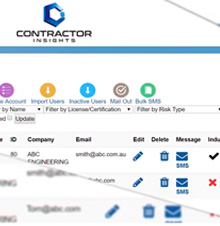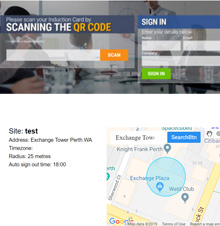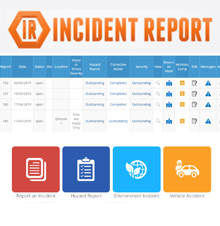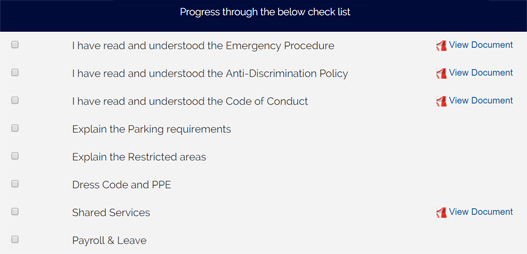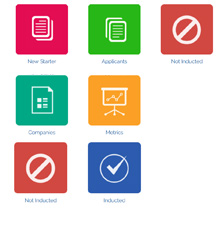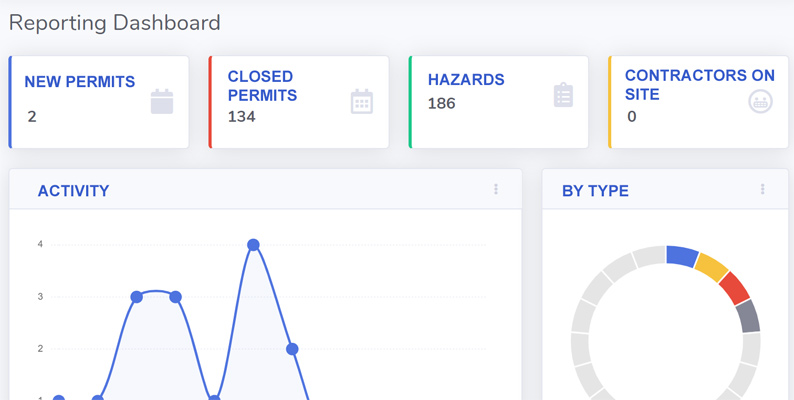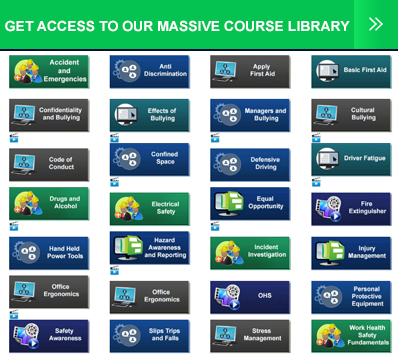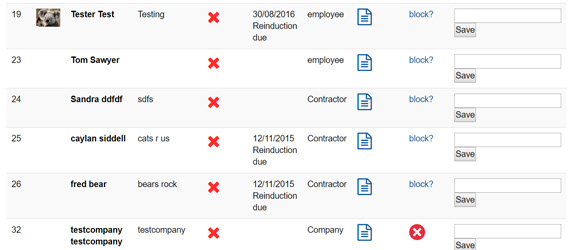Contractor Onboarding: Resources, Setup and Guide to Onboarding Contractors
Online Induction >> Onboarding Program >> Contractor OnboardingPublished 02/09/2025
What is contractor onboarding and why is it important to onboard contractors?
 Generally, contractor onboarding is a standardized process that the newly hired contractors undergo before or immediately after beginning their work which is designed for efficiency improvement and reduction of risks. The hiring staff teaches them how things work in the organization and nurture them to highly productive seasoned hires.
Generally, contractor onboarding is a standardized process that the newly hired contractors undergo before or immediately after beginning their work which is designed for efficiency improvement and reduction of risks. The hiring staff teaches them how things work in the organization and nurture them to highly productive seasoned hires.
Onboarding is done when the contractor being hired knows very little about the organizational structure. So it becomes a critical situation for the organization's staff to offer a strong impression of the value they place on safety to the contractor.
Establishing a Contractor Onboarding Program
Contractor onboarding programs tend to mitigate the risks posed by contractors safety practices and attitudes on the safety culture of the firm. It creates uniformity in the system of safety norms practiced by all the other workers which encourages them to accept and follow the safety culture that is desired in that particular organization.
An effective onboarding process accelerates the progress of the contractor and results in a better outcome faster. Most organizations may get more benefits from an efficient onboarding program than they even realize. An overall onboarding strategy will help with ensuring your onboarding process has the right structure, goals and setup.
- It's easy to repeat the process when hiring in the future if you have an established onboarding system
- It makes it easier to scale especially for those companies that often depend on contractors instead of having full-time staff personnel.
- Contractor onboarding helps the contractors to quickly get started with the project they are set out to do especially on time-sensitive projects. This means that if you have a clearly defined onboarding process you will save a lot of time that's wasted when trying to get them set up with the other teams of the organization.
- Onboarding contractors ensure that they are successful, do a good job for your organization, and also make everybody's life in the organization easier.
This will form a major part of your overall contractor management system.
What typically do you include in a contractor onboarding process?
 The contractor onboarding process usually entails training and screening contractors to ensure that they are in line with the organization's safety, policies, and procedures that they should follow while working on a given project. The process also prompts the contractor to accept certain values and operational principles associated with the organization.
The contractor onboarding process usually entails training and screening contractors to ensure that they are in line with the organization's safety, policies, and procedures that they should follow while working on a given project. The process also prompts the contractor to accept certain values and operational principles associated with the organization.
It is critical to have in place many safety and human resource materials for the contractor to go through before they are started on the roles they are hired for. Some of the common items to include are:
What you might include in the Contractor Onboarding Process
- Documents. All paperwork including the documents to be signed needs to be dealt with before the work starts. These documents include nondisclosure agreements, letter of intent, contractor agreement, W-9 forms, etc
- The items needed by the contractor. Before they big work, contractors need various items and tools to accomplish their tasks e.g. a functioning workstation, ready to use time cards, permissions to documents, logins, and passwords to the necessary systems, security passes, and induction timetable.
- Information related to the task. All the information related to the project needs to be clearly stated such as the expectations of the project, software to be used, procedures for dealing with expenses and time, how to report issues, and the communications platforms to be used. When the contractor is equipped with the necessary information he will not need to stop to ask for anything after he begins working on his project.
- Safety information to be aware off such as risks and hazards on site
- How to manage and report a permit to work
Including these areas as part of an online contractor onboarding workflow helps prepare contractors for their job task or activity on site. You might slip this up as well into stages such as a day 1 onboarding journey, week 1, month 1 and have a staged approach around important onboarding content for your contractors.
Guide to setting up Contractor Onboarding
 A good place to start is by identifying what you want to have contractors go through as part of their onboarding journey. This might involve mapping out important safety content for them to understand such as risks and hazards to be aware of across the workplace. It could involve conveying specific safety policies and procedures for them to be trained on, establishing the collection of licenses and certifications for contractor credential checking and verification and any check lists you also need them to acknowledge and understand.
Some questions you might ask yourself as part of this discovery phase for the setup could be:
A good place to start is by identifying what you want to have contractors go through as part of their onboarding journey. This might involve mapping out important safety content for them to understand such as risks and hazards to be aware of across the workplace. It could involve conveying specific safety policies and procedures for them to be trained on, establishing the collection of licenses and certifications for contractor credential checking and verification and any check lists you also need them to acknowledge and understand.
Some questions you might ask yourself as part of this discovery phase for the setup could be:
- What roles need to be onboarded, are there high risk roles that need extra training and a more comprehensive onboarding process?
- What sites do we need to setup contractor onboarding for? Do they need to be site specific?
- How often should the onboarding be conducted for contractors? is there a pre-day 1 workflow or follow up nudges, prompts and actions post day 1?
- Are there project specific onboarding journeys to create?
This will help form the overall picture of what needs to be established for your contractor onboarding.
Try creating a contractor onboarding workflow or look at existing contractor onboarding structures and templates right here:
Create a Contractor Onboarding Journey

Create a Contractor Onboarding Journey

What steps would you have in a contractor onboarding setup?
 The process of onboarding contractors usually begins with their initial induction. It is usually an ongoing process but not a single day event and needs to be started even before the initial start date of the job. Here are some steps you need not forget to ensure your contractor has everything they need to have a good start.
The process of onboarding contractors usually begins with their initial induction. It is usually an ongoing process but not a single day event and needs to be started even before the initial start date of the job. Here are some steps you need not forget to ensure your contractor has everything they need to have a good start.
1. Get all the documents ready
Paperwork is usually tiresome but it's a legal requirement to ensure that you are accomplishing everything overboard. The documents that need to be prepared include Tax documents such as W-8 or W-9s, employee handbooks, letters of intent, payment information, NDAs or confidentiality agreements, and contract/agreements that outline the terms of the deal. Furthermore, all the documents that need to be signed should already be in place for the contractor to sign as soon as they start.
2. Provide and grant the contractors access to all the necessary tools
It's very disappointing for a contractor to get signed up to work on a given project and later find out that they do not have access to the file, software, and accounts you need to accomplish your work. You can make a list of any access the contract might need to do their work and if you're not sure you can just ask them.
3. Do all the necessary training
Contractors usually prefer handling paperwork before their start date but in the cases where some training is required, they need to be taken through it at the start of the project as it takes some time to be accomplished. This is specifically important for instance, for those contractors who need to get used to your software, you are supposed to dedicate some days in the first week to train them on how to use it.
4. Go through everything again on the first day or week
To ensure that the project goes on smoothly, make sure that you utilize the first day or week effectively. It's essential to do a quick refresher about the project on the first day if there was a time gap between the actual start dates and the time you had originally agreed.
Why onboarding contractors online is important and before they arrive on site?
The online onboarding systems are critical points when onboarding new contractors even before their first official day in the workplace. It usually ensures that they're compliant, ready for the job, and conversant with the proper procedures and policies to invest in during their project or job. Apart from increasing retention, there are other many benefits of online onboarding for contractors. They include:
- The organization's clout is boosted through a seamless onboarding flow that gives the organization a technical prestige.
- A well-designed onboarding program for contractors can be used repeatedly as a template for future hiring processes. This is very important mostly when you're planning to scale the operations.
- There are less confusion and drop-off. The staff onboarding contractors are pretty incredible about the information to share with the contractors being onboarded and how they'll share it.
- The admin benefits galore. The old fashioned paper works make many companies suffer administration overhead and bloat but with online onboarding, you don't need to use a lot of papers which is a major step for any organization.
Sample Contractor Onboarding Workflow

Sample contractor onboarding workflow map: from prequalification around safety and procedures through to onboarding and compliance
Tips around when to Onboard Contractors
 One important issue that should determine when you will start working with a contractor is how long the project will run for. If the project duration is quite lengthy, then it may make sense to onboard them sooner rather than later so they can play an integral role from the beginning. This way, they gain knowledge about procedures and processes as well as familiarize themselves with product development goals before delivering any results.
One important issue that should determine when you will start working with a contractor is how long the project will run for. If the project duration is quite lengthy, then it may make sense to onboard them sooner rather than later so they can play an integral role from the beginning. This way, they gain knowledge about procedures and processes as well as familiarize themselves with product development goals before delivering any results.
Another factor worth considering when deciding whether or not to onboard contractors is their skillset - do they match up with what needs doing exactly? Knowing what qualifications and capabilities someone brings makes for smoother vetting processes prior to making any hire recommendations or decisions - this will reduce costly mis-hiring mistakes but also unnecessary spend which could have been allocated elsewhere more effectively!
Finally, take into account your business objectives at large in relation to short-term responsibilities too; weighing up potential cost versus benefit of taking on outside contractors against prioritizing current projects already underway internally can help ascertain if and when there would be most value added by tapping external resources API documentation)
What happens when you don't onboard contractors?
Some organizations usually don't value onboarding contractors when they're hiring due to lack of a formal onboarding program or they have a partially designed onboarding set up.An organization will spend large amounts of money on contractor turnovers and loss of productivity if it lacks a standardized onboarding process that acquaints the new hire with the company.
When you fail to onboard contractors, they will always have an overall lack of information, stay with unanswered questions, and have a lack of understanding of what they should do and the current processes of the organization. Sloppy work is the final outcome.
The new contractors will tend to be stressed, less productive, and overwhelmed with the feeling of being disconnected from the rest of the team then their chances of looking for jobs elsewhere are likely to be high.



